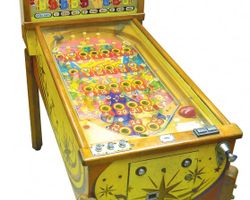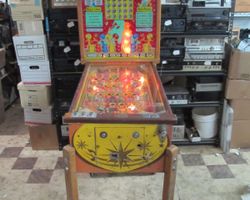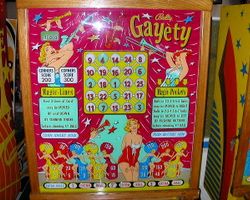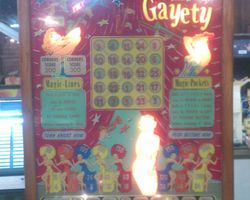Gayety
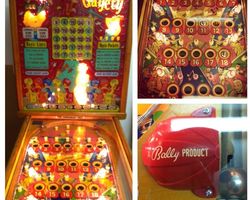
Average Prices: USD $200 to $500
Produced: 0
Machine Type: Electro-mechanical
Players: 1
Design by: Don Hooker
"Gayety," an electro-mechanical (EM) pinball machine released by Bally Manufacturing Co. in February 1955, stands as a notable example of the era's bingo-style games. Designed by Don Hooker, this one-player machine sought to blend the elements of chance inherent in traditional bingo with innovative player-controlled features, injecting a significant layer of skill into the experience. As a "woodrail" machine, its construction and aesthetic are characteristic of its time, featuring a substantial wooden cabinet and a vibrant, hand-drawn playfield that invited players into a world of lighthearted competition. Its development period in the mid-1950s was a fertile ground for experimentation in pinball, and Bally, a dominant force in the amusement industry, consistently pushed the boundaries of EM design. A key innovation that defines "Gayety" is tied to Patent No. 2,864,620, filed by Donald E. Hooker and Charles G. Troeller, covering "BALL TRANSFER AND SWITCH MEANS." This patent underscores the technical ingenuity behind the machine’s unique interactive features, particularly its "Magic Pockets." An interesting note from its production run concerns the initial design of ball draining from the top row of holes. Balls resting in these positions at the start of a new game would roll slowly down the playfield, causing a delay. Feedback from operators and players likely prompted a design revision, as evidenced by a faster ball return solution implemented in Bally’s subsequent 1955 game, "Gay Time," which featured a dedicated ball return hole near the seventh top-row pocket. Reports suggest this improvement might have been retroactively applied to some "Gayety" machines during their production.
Signature Features and Design
"Gayety" is primarily defined by its innovative "Magic Pockets" and "Magic Lines" features, which elevate it beyond a simple game of chance. The playfield is dominated by a grid reminiscent of a bingo card, but the interactivity sets it apart. The "Magic Pockets" consist of seven numbered holes (1 to 7) positioned along the top row of the playfield. These are not static targets; when a specific feature is lit, players can, via a button on the lockdown bar, activate two-way kick-out mechanisms within holes 2 through 6, allowing balls to be strategically transferred left or right along this top row. Hole 7 also possesses this two-way capability, though its primary function at game start was to kick balls to the right. This unique player control over ball position introduces a strategic element, transforming what would typically be a purely random drop into a deliberate choice. Complementing this is the "Magic Lines" feature, which allows players to dynamically move lit numbers vertically up and down across the first three lines of the bingo grid. This power to manipulate the game board itself provides numerous opportunities to create winning combinations, greatly enhancing the player's agency. Beyond these core mechanisms, "Gayety" features 25 trap holes where balls can settle, along with 7 kick-out holes that return balls to the playfield after specific events. The entire presentation, from the woodrail cabinet to the vibrant graphics, conveys a sense of vintage charm. The artwork on the playfield and backglass is typical of the mid-1950s, employing bright colors and inviting scenes that contribute to the machine's overall aesthetic appeal.
Playfield and Mechanics
The playfield of "Gayety" is structured around its primary objective: completing lines on a single bingo card layout. Balls are launched via a manual plunger onto the main surface, where they descend into a series of numbered trap holes. The core interaction, however, unfolds at the top of the playfield with the row of seven "Magic Pockets." Once a ball lands in one of these holes, and the "Magic Pockets" feature is active, the player gains control. Buttons on the lockdown bar correspond to specific movements, allowing the player to actuate internal kick-out mechanisms that shunt balls left or right between adjacent pockets. This precise control over ball placement, particularly within the crucial top row, is central to the game's design philosophy. The flow of "Gayety" encourages players to aim for these top pockets to then orchestrate their ball positions. From these positions, balls may eventually drain back onto the main playfield or contribute to scoring. The artwork on the playfield is meticulously detailed, with a clear grid for the bingo card, vibrant numbers, and various illuminated indicators that guide the player. Lighting plays a crucial role, indicating which numbers are active, which features are enabled, and where potential winning lines are forming. The overall aesthetic is one of inviting complexity, where the mechanisms are clearly visible but the strategic depth unfolds through play.
Gameplay Dynamics
The gameplay of "Gayety" revolves around a multi-layered progression system, blending chance with strategic decision-making. A game typically begins with the player inserting credits, which can then be used to activate various features or enable additional balls. Once a game starts, balls are launched onto the playfield, aiming to land in the numbered holes. The immediate objective is often to get balls into the top row of "Magic Pockets" (holes 1-7). When the "Magic Pockets" feature is lit, players can then engage their strategic faculties. By pressing a dedicated button, they can selectively shift balls between these top-row holes. This allows a player to maneuver a ball into a more advantageous position, directly influencing which numbers light up on the main bingo card. For instance, if a ball lands in hole 4 but the player needs it in hole 3 for a potential line, they can, if the feature is active, shift it left.
The second critical dynamic is the "Magic Lines" feature. As balls light up numbers on the grid, the player can activate "Magic Lines" to vertically shift entire rows of lit numbers. This is where complex strategies emerge. A player might have three lit numbers that don't form a line horizontally but, by shifting one or two rows up or down, could create multiple winning combinations. This transforms the game from merely hitting targets into a puzzle of spatial reasoning and timing. Players must anticipate which numbers they need, assess the current board state, and decide when to spend credits or activate features to maximize their chances. The scoring system is directly tied to completing these bingo lines, with different line combinations potentially yielding varied payouts. The thrill lies not just in a lucky shot, but in executing a series of calculated moves to turn an improbable arrangement of numbers into a winning pattern. It demands a level of engagement and foresight that sets it apart from many other EM machines of its era.
Reception and Legacy
"Gayety" generally received an overwhelmingly positive reception from both players and the nascent pinball community, particularly among enthusiasts of woodrail bingo machines. Its greatest strengths were consistently cited as its distinctive "Magic Pockets" and "Magic Lines" features. These innovations were praised for transforming what could otherwise be a game of pure chance into one that demanded significant player skill and strategy. Players valued the ability to influence ball placement on the top row and to manipulate lit numbers on the bingo card, leading to a much deeper and more engaging experience than many of its contemporaries. Beyond its mechanical ingenuity, "Gayety" was also admired for its aesthetic qualities, frequently described as a "beautiful looking woodrail" with a "gorgeous playfield and wood rails." Its inviting visual appeal contributed significantly to its popularity. Despite the depth offered by its features, it was also noted as "not that complicated to understand or learn how to play," making it accessible to a wide audience while still providing substantial challenge for dedicated players. Its ability to hold a player's attention was evident, with reports of enthusiasts playing it for extended periods at events. For collectors specifically interested in the golden age of woodrail bingo machines, "Gayety" remains a highly recommended acquisition due to its unique gameplay and enduring charm.
However, the machine was not without a notable weakness, albeit one unrelated to its gameplay. Some early models or specific instances of "Gayety" presented a safety concern due to the significant weight concentrated in the machine's head, which could fall backward if not properly secured, posing a risk of injury during transport or maintenance. While this was a rare occurrence, it highlighted a design consideration of the heavy EM heads common to the era. Despite this physical characteristic, "Gayety" cemented its legacy as a pivotal machine in the evolution of bingo pinball. Its innovative player-controlled features, particularly the "Magic Pockets" patent, demonstrated Bally's commitment to pushing the boundaries of interaction, setting a precedent for more complex player agency in future pinball designs. It stands as a testament to the creativity of mid-20th-century pinball engineers and artists, securing its place as a significant and highly regarded example within the extensive history of electro-mechanical amusement machines.
Sponsored Links
 Ebay Listings
Ebay Listings
 Auction Results
Auction Results
| Cost | Location | Date |
|---|---|---|
| USD $500 |  Illinois, United States Illinois, United States |
12 December, 2018 |
| USD $425 |  Washington, United States Washington, United States |
09 May, 2018 |
| USD $175 |  Iowa, United States Iowa, United States |
06 November, 2016 |
| USD $375 |  Indiana, United States Indiana, United States |
03 May, 2016 |
| USD $500 |  Washington, United States Washington, United States |
16 April, 2016 |
| USD $375 |  Indiana, United States Indiana, United States |
07 April, 2016 |
| USD $500 |  Missouri, United States Missouri, United States |
24 September, 2014 |
| USD $213 |  North Carolina, United States North Carolina, United States |
01 May, 2014 |
| USD $406 |  Ohio, United States Ohio, United States |
11 February, 2013 |
| USD $1,995 |  Pennsylvania, United States Pennsylvania, United States |
04 February, 2013 |


Private Policy · Search Website · Contact Us
As an eBay Partner, we may earn a commission from qualifying purchases made through links on this site, at no additional cost to you.
All trademarks and copyrighted materials remain property of their respective owners. All other content copyright 2007 - 2025 Pinpedia.

